Marjory McGinn's Blog, page 6
September 2, 2013
My big fat Greek love affair …

LAST week started off quietly enough, writing a few stories to promote my book here and there; some social networking. But by Monday night all that had been swept away. I found myself in the centre of a mini media frenzy in Greece. As a journalist, I am used to being on the other side of the notebook, so this was something new.
It followed a recent interview I’d done with the editor of Australia’s esteemed Greek newspaper Neos Kosmos about why I and my partner Jim, and our dog Wallace, went to live in the wild Mani region of Greece for three years during the economic crisis, which became the subject of my book, Things Can Only Get Feta.
I was sent a link on Monday to the published story in the Greek edition of the newspaper. But it wasn’t quite the story I’d expected. The Mani adventure was certainly there, but this had a different spin. Here was a story that exposed me irrevocably as a woman who has had a long love affair – with Greece. Outed!
I blushed as I read about “the unbelievable story” of my “erotic relationship” with the country, and that I had been “besotted with the place” from the first moment I had set foot on Greek soil as a youth.
All true, and the feature was written affectionately and without irony by Greek-Aussie editor Sotiris Hatzimanolis. I have indeed been in love with Greece all my life, from a fateful childhood friendship with a Greek girl called Anna in Australia, as a shy Scottish migrant, to my regular jaunts there ever since.
I didn’t think for a minute that Greeks would be moved by the passion of one foreigner for Greece. Boy, was I wrong, as the response to the story proved. Sotiris had known something about the Greek psyche at this moment in time that I didn’t.
[image error]
The article in Australia’s Greek newspaper Neos Kosmos, with the headline “An Australian journalist in love with Greece”.
The Neos Kosmos piece was picked up quickly by an Athens press agency and sent out everywhere in Greece. By Monday evening it was on most internet news site and blogs – splashed with a similar headline “A Scottish journalist’s love affair with Greece”. One headline simply yelled, “Marjory McGinn in love with Greece”, like something you might have seen scrawled on the bike sheds in primary school.
The stories were sometimes revamped and occasionally in English, with a quaint Google-style translation. In one instance I was described as having “the most erotic relationship with Greece”, as if I’d just written a novel called Fifty Shades of Greece. I wish!
Greece and I do have a history, yet I have skirted around the issue of my affection for Greece most of my life because I’ve found that other people feel uncomfortable when you confess your love for a country, especially one that’s not yours.
By Tuesday, several Greek newspapers had contacted me for interviews and ran features in the following days, and one Athens TV station was keen for a live interview, but there were problems with the link-up and it’s still pending. Which is just as well. I think the Greeks have enough problems at present without having to listen to my less-than-perfect Greek.
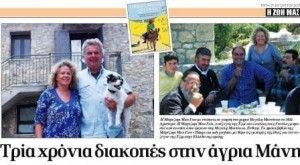
Another feature in Athens daily newspaper Dimokratia
But this welcome publicity for the book isn’t the main point I want to make here.
The story Sotiris wrote had struck a chord with Greeks still suffering through the crisis, jaded and tired with their troubles. And the response to it was enormous. Our website, named in the stories, suddenly had 150,000 hits in three days – which crashed the site at one point. And there was a flood of emails, mostly from Greeks, with messages of thanks to an unknown foreigner for saying something nice about Greece for a change.
It made me realise how, over the past four years, there has been so little written about Greece that hasn’t been pessimistic, blaming, insulting at times.
Greeks have suffered critically during the crisis, as has been well documented already, but what I don’t think has been conveyed so accurately in the international media is how the crisis, and the effect of the austerity measures, has crippled their self-confidence as well as their standard of living. Many Greeks told us, when we were living in the Mani, they were ashamed of how low their country had sunk, even though it wasn’t all their fault.
So I want to share a few of those thoughts and wishes (both serious and light-hearted) from my recent correspondents (full names withheld). All the emails sent were sent in English.
“Thank you for being gracious toward Greece in these difficult times. We Greeks have been subjected to pure and evil racism because of the crisis, with an intensity that we never expected. In (some European countries), patients in hospital have said they don’t want to be examined by Greek doctors just because they are Greek. Greeks have been bullied because of the usual stereotypes. Greece is not perfect and there are many things to be corrected, but it is very unfair for Greece to be demonized the world over.” – Stergios
“Your story has made me really happy. It is an inspiration to Greek readers who really need something like this right now.” – Kelly
“I felt proud and grateful when I read about you and your love for Hellas (Greece). I would like to thank you for coming to my country and wishing that Greeks would love this country as much as you have.” – Giorgos
“Any anthropos (person) who falls in love with this place isn’t (doing it) by accident. For your information, Hellas (Greece) loves you back. We are living the economic nightmare here that those who would call themselves “human” have played out on us. I know we will win as long as we are together and help each other.” – Stephanos (Greek American living in Greece)
“I am so proud that you would visit my country, my people, my beloved places. Thank you so much for what you have done for us. I want you to come here again to love us more, to feel the Greek hospitality.” – Olga
From a woman who thought we were still in the Mani: “We will be beside you and protect you as guests. Greek hospitality is great to those who respect us. Our country is your country.”
And lastly, a comment sent to my Facebook page from Kyriacos: “Way to go, Marj! You are a pure Hellenic lady. Be well.”
So, what’s not to love about Greece and its warm-hearted people? Here’s my similar wish for the country. Be well! Or, as they say in Greek, na eiste kala.
For details about the book visit www.bigfatgreekodyssey.com and www.facebook.com/ThingsCanOnlyGetFeta
To buy the book see http://www.amazon.co.uk/Things-Can-Only-Get-Feta/dp/1909657085/ref=tmm_pap_title_0?ie=UTF8&qid=1372615062&sr=1-1
© Text and photographs copyright of the authors 2013
To leave a comment please click on the comment link below
July 7, 2013
Southern Peloponnese is the star attraction

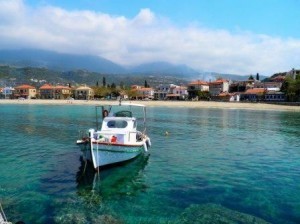
Stoupa beach in the Mani
THE Hollywood movie Before Midnight is now doing the rounds with mixed reviews, but one aspect is indisputable – the real star of the piece is the southern Peloponnese.
Focus on this wonderful region of Greece has been long overdue. Having spent three years living in the Mani region (situated in the middle of the three peninsulas), I can vouch for its beauty and real authenticity.
From my experience there, I have drawn up a list of some favourite places to visit, mostly in the Mani. The recommendations for tavernas and other businesses are based on my personal taste alone. Come to the region one day so you can draw up your own list of favourites.
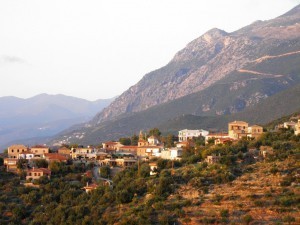
Hillside village of Megali Mantineia
* BEST HILL VILLAGE: Megali Mantineia, in north Mani.
There are many lovely rural villages in the southern Peloponnese but this is my favourite, partly because my partner Jim and I, and our mad Jack Russell dog Wallace, spent the first year of our Greek adventure here and it was the inspiration for my book Things Can Only Get Feta. It’s a short drive from popular Santova beach and nestles on a quiet hillside beneath the north Taygetos Mountains. It’s an unspoilt village with a tight-knit community where most people work as goat farmers or harvest olives.
Unusually for a rural village, there are four very good family-run tavernas here offering traditional dishes. The Lofos (27210 58630), with its vast terrace overlooking the Messinian gulf is on the drive up from the sea; Iliovasilema, or more commonly called Yioryia’s after the owner’s wife (27210 58660), and nearby Sotiris Taverna (27210 58191); Anavriti Taverna (27210 58062), behind the main church, and the Kali Kardia kafeneion in the heart of the village (27210 58306).
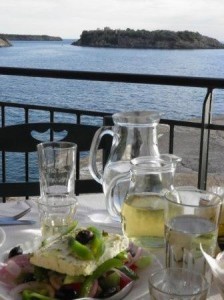
Dining experience in Kardamili
* BEST COASTAL VILLAGE: Kardamili
Kardamili is an hour’s drive from Kalamata and is the village where some of Before Midnight was filmed. It has a nice old harbour and pebble beaches. The Taygetos mountains form a picturesque backdrop and there is an historic area with traditional Maniot tower houses. From the village are good walking tracks up to the villages behind, like Agia Sophia and Petrovouni. The late Patrick Leigh Fermor’s house is situated at the southern end beside Kalamitsi beach, with excellent swimming and snorkelling.
Favourite walk: from the old town up to Agia Sophia. Favourite taverna: Hariloas (27210 73373), by the harbour, for its charming owner Maria, and the food, of course. Try the doorstep-sized moussaka, always freshly baked.
Favourite shop: The Bead Shop on the main street of Kardamili (693 9455 365), run by Gill Rochelle. This is a treasure trove of unusual handmade jewellery and a trillion fab beads if you want to get creative while on holiday and make your own. Gill is also very knowledgeable about this area.
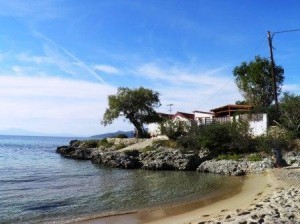
Kalogria beach with the house of George Zorbas
* BEST LITERARY CONNECTION: Kalogria beach
Ten minutes further south from Kardamili is the sheltered sandy cove where much of the book Zorba the Greek was conceptualised. Greek writer Nikos Kazantzakis spent some time here with the real George Zorbas when they were running a lignite mine nearby (see earlier blog post in November for more details). The beach here, where the writer lived in a wooden hut, now demolished, was also the inspiration for the scene in the book where Zorba teaches the narrator to dance the sirtaki. Stoupa is a close second, a long sandy beach nearby with a good selection of tavernas.
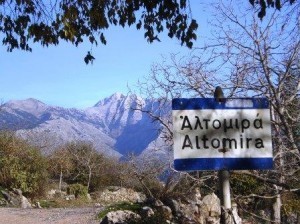
Altomira village in the Taygetos mountains
* BEST LOFTY VILLAGE: Altomira
This is a fabulous village in north Mani at nearly 3,000 ft with a stunning view towards Profitis Ilias, the highest peak in the Taygetos range. The village is partially in ruins, though many Greeks are buying houses and renovating them for summer holidays. The best approach is from the main Kalamata to Stoupa road with the turn-off to Sotirianika, and a 4×4 is recommended.
If you’re a fit, keen walker, there is an old stone kalderimi (donkey track), called the Biliova, from Sotirianika up the side of a hill that will lead you to the village, with great views. You will need to get hold of a local walking map.
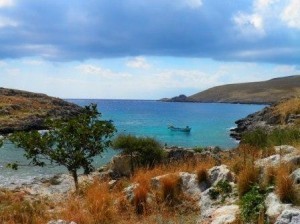
Near the Cave of Hades, Cape Tainaron
* BEST SPOOKY SITE: The Cave of Hades
This is situated on Cape Tainaron at the tip of the Mani peninsula. From the end of the road, at the car park, you take the path down to a nearby cove and the cave is behind a high rocky outcrop, covered by bushes. This is the doorway to the Underworld mentioned by ancient writers and scholars. The place where Hercules performed his 12th labour, dragging out the three-headed dog Cerberus. From here there is a path to some ancient Roman ruins with mosaics and further on is the lighthouse on the southernmost point of Greece.
Favourite taverna: This is on the road down to the fascinating town of Areopolis, and the Cape, at wide Limeni Bay near Otylo. Takis Taverna (27330 51327) is right by the water where fishing boats pull in and land the day’s catch.

Stunning Voidokoilia beach
* BEST BEACH: Voidokoilia
Apart from the long peaceful Santova beach in the Mani, the most perfect, photogenic beach is Voidokoilia, near Navarino Bay on the Messinian peninsula (left-hand prong). Shaped like the Greek letter omega Ω, it has two headlands, one with a ruined Frankish castle on top. The sand here is soft and the water pale and silky. There is nothing much here apart from the beach, so head back towards Pylos town to the fishing village of Yialova with its own sandy beach and a row of nice tavernas and cafes by the water.
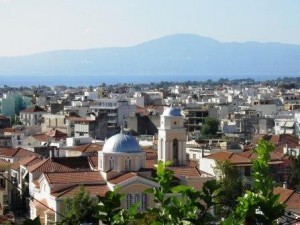
View across Kalamata city centre
* BEST CITY: Kalamata
Okay, it’s the only city of the southern Peloponnese, but as Greek cities go, this one is very appealing. Set at the head of the Messinian Gulf, it has the lot: a long clean city beach; history (the historic centre, Frankish castle, cathedral and archaeological museum); a vibrant café scene along Navarino Street; a bustling marina with a selection of tavernas.
Favourite tavernas: Koilakos for fish, especially calamari and grilled octopus, Navarinou St, 12, (27210 22016); the Argo, Salaminos St 52, (27210 25380). Favourite dish, grilled sardines. The other dish is the lovely Adonis, a very entertaining waiter, and a city celebrity. Ta Rolla, Sparta St, 53 (27210 26218). An old-style taverna in the market area of the city with wine barrels full of a lovely local brew and specialties like bean soup and stuffed tomatoes.
Best monastery/silk workshop in Kalamata:
Head to the 18th century Kalograion (Nuns’) Monastery in Mystra Street (near the Ypapanti Cathedral). Once internationally famous for its silk products, made at the monastery by the nuns, it still produces many lovely items in-house though the nuns number only a couple of dozen these days. The shop here stocks unique hand-printed scarves, embroideries, as well as small icons and religious books.
This is an oasis of calm in the city with a courtyard shaded by orange trees and two small churches. Later, head to the Ypapanti Cathedral to see the ‘miraculous’ icon of the Panagia (Virgin Mary) saved from a fire in the 19th century during a skirmish with the Turks, and the patroness of this city.
Other places to visit in the southern Peloponnese: the archaeological site of Ancient Messene, north-west of Kalamata, close to the village of Mavromati; Nestor’s Palace, one of the finest Mycenaean sites in southern Greece, near Pylos. The twin “eyes of the Venetian empire” Koroni and sprawling Methoni castles at the tip of the Messinian peninsula; lastly, Monemvasia, Greece’s “rock of Gibraltar” in the Laconian peninsula.
For more information about what to see and do in the southern Peloponnese go to our home page on www.bigfatgreekodyssey.com or visit www.mythicalpeloponnese.gr run by the Greek National Tourist Board. A great site for walking tracks in the Mani and other information: www.insidemani.gr

Marjory and Wallace with the new book
A book about living in Greece
For more details about my book, Things Can Only Get Feta (Bene Factum Publishing, London) based on three years living in the Mani, southern Greece during the crisis, visit my website www.bigfatgreekodyssey.com or visit Facebook www.facebook.com/ThingsCanOnlyGetFeta
Visit Amazon to buy the book
To read my recent story in The Scotsman newspaper about the southern Peloponnese please click on the following link: http://www.scotsman.com/lifestyle/features/travel-mani-delights-in-greece-1-2976801
If you are a resident or frequent visitor to the southern Peloponnese please share your favourite place and tell me what it means to you. Click on ‘comments’ link below
© Text and photographs copyright of the authors 2013
To leave a comment please click on the comment link below
June 12, 2013
Interview with the best-selling author Peter Kerr

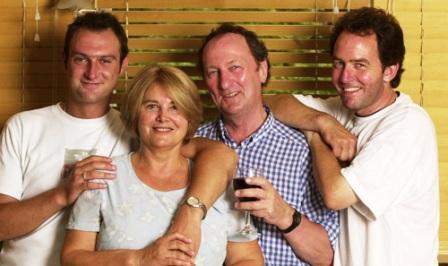
Author Peter Kerr and his family
THIS week on the blog I am featuring the first of some occasional pieces from other writers, talking about their books and their experiences of getting into print.
Peter Kerr, best-selling author of the Snowball Oranges series of Mallorcan books, talks about his work. With a diverse background in record producing and beef farming in Scotland, Peter took the adventurous step of moving to Mallorca in the 1980s with his family to grow oranges, and he turned that experience into very entertaining books. He later wrote a series of mystery novels, and his latest work is an historical novel called Song of the Eight Winds.
Q: Why Mallorca and why orange farming?
A: We had a 50-acre beef and cereals farm in south-east Scotland but it wasn’t viable enough to make a good living when the recession hit in the 1980s. We needed to find another way of life – and fast. Fate intervened during a break in Mallorca, when my wife Ellie and I stumbled upon an orange farm for sale in a hidden valley of the Tramuntana Mountains, in south-west Mallorca.
We knew nothing about growing oranges, and although we didn’t consider ourselves to be creatures of impulse, we bought the farm on the spur of the moment anyway, seriously stretching our finances. This was to be one of those life-changing risks that few of us would gamble on, if we took time to think about it first.
A few months later, we had sold up in Scotland and were in our new Mallorcan home with our two sons – aged 10 and 19. The ups and downs of this venture are fully chronicled in the Snowball Oranges series. Foolhardy though this may have seemed at the time, the experience gave us a lot more laughter than tears, and a much broader outlook on life.
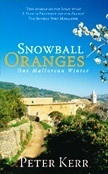
The first in the series of Peter’s best-selling Mallorcan books
Q: You were one of the first British writers to produce travel narratives about expat life in the Mediterranean. What made you want to start writing in the first place?
A: In 1990 I started jotting down random notes about the humorous aspects of our family’s experiences while trying to make a living growing oranges during the 1980s. Two years later, the jottings had morphed into the first book.
And there were plenty of disasters along the way that obviously made great anecdotes for the book, like the first morning, in December, after moving into our Mallorcan farm house. We woke up to find a neighbour banging on our front door, telling us the area had been engulfed in a freak snowstorm. To our horror, we went outside and found the orange orchards covered in a cold mantle of white, hence the title Snowball Oranges.
Q: While the first book became a bestseller, ironically it took a long time to get it published. Why was that?
A: It took eight years to get Snowball Oranges into print and in that time I was turned down by just about every publisher in Britain. I was told that the demand for this type of narrative travelogue had been exhausted by the huge success enjoyed by Peter Mayle’s Provence books (from the late 1980s). However, it seemed to me that there was still a huge demand for this type of travel book that hadn’t been fully satisfied. And my hunch turned out to be right. Snowball Oranges, without any special promotion, became an overnight bestseller when finally published by Summersdale in 2000, picking up a couple of book-of-the-year awards on both sides of the Atlantic, and spawning four sequels and a prequel, which have since been translated into twelve languages.
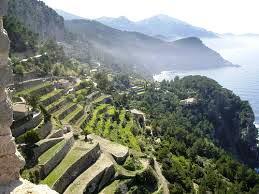
The Tramuntana mountains on Mallorca
Q: Your persistence in getting that first book into print will inspire others but what advice do you have for would-be authors in these difficult times for publishing?
A: Realise that writing ‘The End’ on the last page of your manuscript is, in many crucial ways, only the beginning of your work. Go back and revise everything over and over again until you can almost recite every page by heart. And then revise some more, ruthlessly cutting out or changing anything that you aren’t entirely comfortable with.
Publishers won’t read beyond the first paragraph of any submission that appears slapdash. This is even more important now that self-publishing is so easy to attain. However tempting it may be to take the fast track to seeing your work in print, make sure your manuscript is professionally edited and carefully proof-read before you submit it for publishing. This may cost you a little bit to achieve but it will end up being money well spent.
Q: The travel narrative genre burgeoned in the past decade. Do you think it has now run its course?
A: I think there will always be a demand for the ‘living the dream’ type of story. It’s human nature to suspect the grass is greener somewhere else, particularly if it also happens to be sunnier than it is at ‘home’. The market is flooded with these books now and only those with something different to offer will have the only reasonable chance of success.
Q: Your latest book is also your first historical novel Song of the Eight Winds, also set in Mallorca. What’s it about?
A: It’s an epic tale set in an interesting period of Mallorcan history, in the 13th century during the Christian Reconquista from the Moors. It’s a period of history that has fascinated me and I thought it was ideal for a fictional account. It’s also a new creative direction and proves the old adage: “When opportunity knocks, don’t look through the letterbox before opening the door.”
To find out more about all Peter’s books and to order, visit his website www.peter-kerr.co.uk and follow him on Twitter @AuthorPeterKerr
© Text and photographs copyright of the authors 2013
To leave a comment please click on the comment link below





